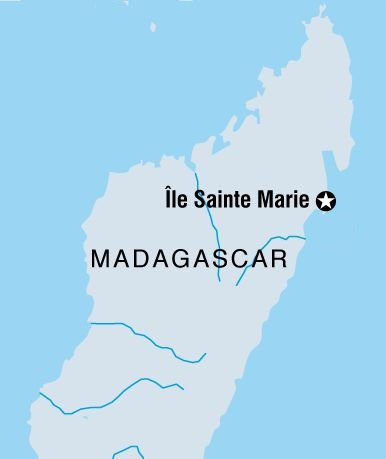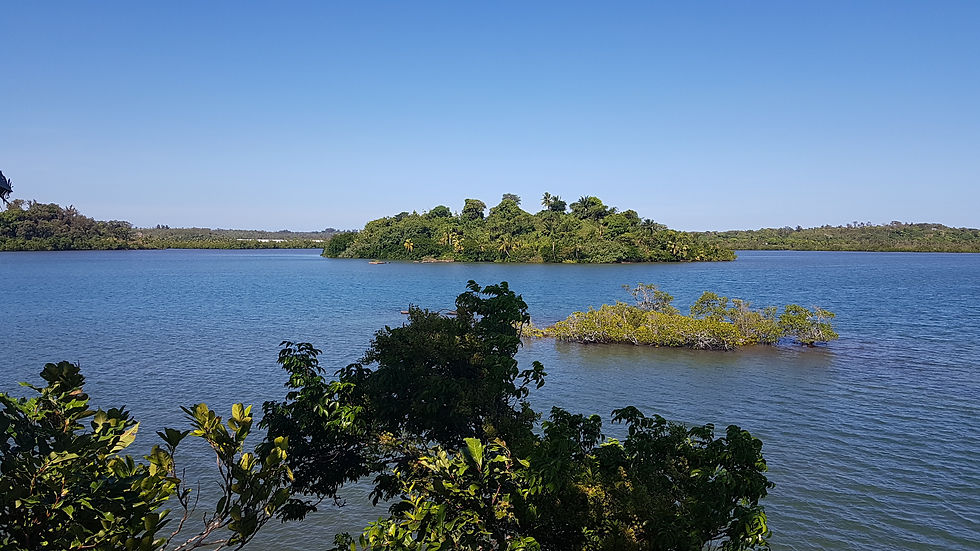Piracy Pays for Paradise
- Kieran Houston

- Jan 14, 2019
- 7 min read
Pirates. Villainized throughout history yet almost glorified in modern times. From Hollywood movies to theme park attractions and countless stories, the reputation of pirates has and will always have its place, whether it be good or bad. In the golden age of piracy back between 1670 and 1720, Madagascar was a hub for pirates all over the world to trade and live among locals. More specifically, a small island off the North East coast called Ile Saint-Marie.
Ile Saint-Marie is around 60km long and 10km wide at its maximum. It bears the feeling of a different world compared to cities on mainland Madagascar like Antananarivo or Toamasina. The central hub of Ile Saint-Marie is a small bay area on the West side of the island.

It’s here where our old pirate friends come into the picture. In 1685 a man named Adam Baldridge fled the Caribbean and sailed all the way across the Atlantic, along the south coast of Africa and to our beloved island, Ile Saint-Marie. Realizing the potential of this small yet fruitful and easily protected land, he began to build a community, eventually reaching a population of around 1000 so called pirates. But, as what tends to happen with pirates, Baldridge became greedy. He had built warehouses, ports and even a grand old fort high up on the hills overlooking the bay. Unlike a lot of pirates, Baldridge never followed a code. He held and traded slaves, valued his life among other men. He charged extortionate prices for rum and supplies before sending weary merchants on their way. Eventually in 1697, Baldridge got what was coming to him. He began to sell the local native population of Ile Saint-Marie as slaves and ofcourse, sparked an uprising. He was driven from the island and fled back to The Americas. Baldridge was never doing anything illegal so on his arrival to New York he was greeted and pardoned for any acts he may have committed before making a desperate recommendation to anyone willing to listen. He told people of Saint-Marie. Its potential, its location and prospering fauna. But sadly for Baldridge, nobody listened, he grew old, married a sailors wife and died in his 70’s, and that was the end of that.
Among the pirates to visit and trade with Baldridge was a man named Thomas Tew in the early 1690’s. Not much is known of Thomas Tew’s exploits in Madagascar however he is believed to have resided on a small island within the bay of Ile Saint-Marie called Ile Aux-Forbans, The forbidden island.

Tew is rumoured to be the father of a man named Ratsimilaho, who in turn is father to a lady named Madame Betty, who in turn lived and prospered on Ile Saint-Marie, even becoming queen and having an island at the entrance to the bay named after her, Madame Island. Thomas Tew dedicated his many years of piracy to the Indian ocean. Capturing countless Mughal trade ships from India and thriving from their rich resources of silk, spices and jewels. Eventually, Thomas Tew met his end whilst pursuing a Mughal vessel and was blown to pieces by a cannonball. As is the usual custom with pirates, he met a gruesome end, and his crew surrendered themselves to the noose.

One of the most famous legends surrounding Ile Saint Marie is the fabled pirate utopia of Libertalia. The only actual proof Libertalia ever existed comes from a book written by ‘Captain Charles Johnson’, considered to be a pseudonym for Daniel Defoe. In this book he writes about a pirate utopia that lasted for 25 years. A paradise where pirates lowered their flags and lived together in peace as merchants, farmers, and equal men. The founders of this so called paradise were Captain James Misson and a priest by the name of Signor Caraccioli. The pirates who settled in Libertalia were fighters for the oppressed, guardians of peoples rights and strived for equal justice to all men. Former slaves lived as free men. No creed, race, colour or religion could separate one man from another. Freeing them of their own nationalities, they became ‘Liberi’. Our old friend Thomas Tew travelled to Libertalia in the beginning of its existence, he aided in liberating a slave ship and breaking the shackles of many locals being sold into slavery, gifting them a new life of liberty. Whether or not Libertalia itself ever existed or if it was simply a metaphor for life after piracy is unknown, but its nice to believe these stories sometimes.

So with all the history put aside, I took a two week trip to Ile Saint-Marie from my working days in Antananarivo. It was Christmas. I arrived on the island on the 22nd of December and began to explore. The pirate cemetery. A merchants graveyard. With the majority of graves being from 1850’s, I questioned the compulsory guide on its actual validity, knowing the last pirates to leave Saint-Marie were in the late 1700’s. I didn’t receive much proof, so, a merchant’s graveyard it seemed. Merchants and privateers, men who settled and married locals and became locals. Besides the single grave bearing a skull and cross bones, it was your usual burial site. A large iron cross forged into a cannonball sat about the grave of the first mate of ‘La Levrette’, who died in 1875. These men were most likely ashamed to be referred to as pirates, yet this title will stay with them as they slowly turn in their graves.
Ile Aux-Forbans was my main destination. It was home to many pirates who sailed into Saint-Marie. I rented a kayak and headed off towards the island. After suffering from the heavy heat and choppy sea, I reached the island and began to explore. The remains of fishing pools, wells, man made paths and foundations were surrounded by overgrowing fauna. The stone pier, broken and buried. Only partly surviving and being relentlessly pummeled by the current. I spent a while exploring the island before a fisherman appeared with a tourist. Apparently its slightly frowned upon to go to the island alone. He informed me of a few facts about a tunnel which led from Ile Aux-Forbans all the way back to the mainland of Saint-Marie, to an area where now stood the oldest catholic church in Madagascar. What was left of Ile Aux-Forbans was now sunken into the ground and returned back to the earth.

After many days of exploring the island and lying around drinking rum and eating mango on the beaches, I began to itch for another adventure. I remembered Baldridge and his fort. Surely a fort of that stature could not be just simply lost to nature. I asked around, nobody had even heard of Baldridge nevermind his fort. I began to give up until on a walk around the bay across madame island, I noticed upon the largest hill to the north of the bay, a few broken looking walls. I followed the walls with my eyes and noticed they seemed to circle the highest point and loom down over the bay area. I was pretty certain this had to be Adam Baldridge’s fort. I approached the fort closer and closer until I began to realize that ofcourse, this strategic masterpiece would never be left to ruins. It had become a military fort. With signs adorning every angle of the hill warning trespassers, I circled the fort for a legitimate entrance. Through shacks and along muddy paths with native eyes watching my every move I found the solemn hill climbing to the base of the fort.
The rain began to pour and I trudged along. In Saint-Marie, when it rains, everyone retreats to their homes or the nearest shelter. Perfect for sneaking into a military fort. Up and up and up I climbed till I reached the outskirts of the fort. The walls looked genuine enough, definitely pre 20th century. Cracks along the walls allowed for a peak inside, nothing was in sight, I began to wonder if it was even occupied. A big iron gate stood between me and the entrance to the fort.


I circled around in search for a less legitimate way in and stumbled across a date stone. 1866. Almost 200 years post Baldridge’s exploits on Ile Saint-Marie. Although I had a constant grin from the adventure I was still rather disappointed. During my return I decided to approach the gate for a clearer view and a possibility to even gain entrance to see if this outer shell from 1866 wasn’t infact just a surrounding fort covering up Baldridge’s original from the 17th century. But, upon approaching the gate, my confidence was knocked by the sight of a camouflaged rifleman patrolling the inside walls, and that was the end of that.
Two of the most famous shipwrecks off the coast of Saint Marie sit close by Madame Island. The first of which being Captain Condent’s ‘Fiery Dragon’. But I was more interested in the second. Captain Kidd’s infamous Adventure Galley. Captain Kidd came to Madagascar as a privateer on a hunt for pirates, one of which was the aforementioned Thomas Tew. Somewhere along the line, Kidd realized that a life of piracy suited him better. He went rogue, became a pirate. He sailed the Indian ocean hunting Mughal merchant ships and even took one of the most lucrative loots in all of pirate history. Captain Kidd had become a successful pirate by the time he began to settle on Ile Saint Marie. But, by that time, his pride and glory The Adventure Galley was a rotting shell of a ship. He stripped every single piece of metal, including the hinges of doors and the bolts and nails and sent the carcass that once was the Adventure Galley to the bottom of the ocean. It’s possible to dive and see the adventure galley today but don’t expect to find any treasure, Kidd took it all when he fled on a captured Mughal man o’ war. Eventually Kidd met an unfortunate end, captured and returned to England, he was hanged high over the River Thames as a reminder to all passersby that the only thing guaranteed from a life of piracy, was a bottle of rum and a painful death.

The locals of Ile Saint Marie seem very unaware of the history that surrounds them. Some find a living from it, offering tours on their fishing boats and even naming bars and hotels in typical pirate fashion. Hotel Libertalia, one of the most expensive luxury hotels, even has its own beer bearing the same name. With the exception of the very few guides who barely even recognized a name or location, I seemed to be the only one on the whole island interested. After a trip to the before mentioned oldest church in Madagascar, I sat for a while in the shade by the entrance of the bay. Skimming stones and just taking it all in, I imagined the sight of a ship sailing down the coast, turning by Madame Island as lookouts watched down from Baldridge’s fort. Sailing into the bay to this pirate paradise to be welcomed with open arms. If a place such as Libertalia ever existed, then I imagine it was very much a peaceful place. A place where all men were equal, the food was shared and the rum flowed straight from the barrel. But some things are better left unknown.
But only some.



Comments